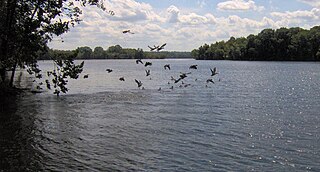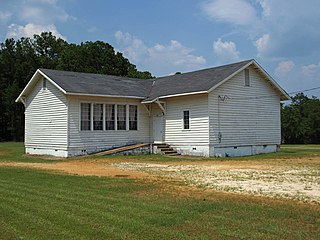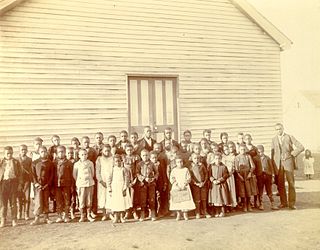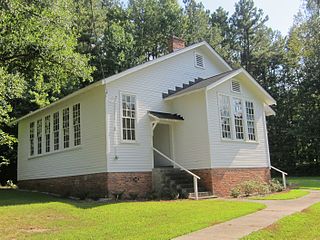
Sumner County is a county located on the central northern border of Tennessee in the United States. As of the 2020 United States Census, the population was 196,281. Its county seat is Gallatin, and its most populous city is Hendersonville. The county is named after an American Revolutionary War hero, General Jethro Sumner.

Gallatin is a city in and the county seat of Sumner County, Tennessee, United States. The population was 30,278 at the 2010 census and 44,431 at the 2020 census. Named for United States Secretary of the Treasury Albert Gallatin, the city was established on the Cumberland River and made the county seat of Sumner County in 1802. It is located about 30.6 miles northeast of the state capital of Nashville, Tennessee.

Cairo Rosenwald School is a former school for African-American children located in the unincorporated community of Cairo, Sumner County, Tennessee. It was one of seven Rosenwald schools built in the county.

Gallatin First Presbyterian Church is a historic church in Gallatin, Sumner County, Tennessee, affiliated with Presbyterian Church (USA).

The Hope Rosenwald School, also known as Hope School, is a former school at 1971 Hope Station Road near Pomaria, South Carolina. As a Rosenwald School, it served rural African-American children in the early 20th century.

Bledsoe Creek State Park is a state park in Sumner County, Tennessee, in the southeastern United States. The park consists of 169 acres (0.68 km2) managed by the Tennessee Department of Environment and Conservation. The park spans much of the west shore of the Bledsoe Creek embayment of Old Hickory Lake, an impoundment of the Cumberland River created with the completion of Old Hickory Dam by the U.S. Army Corps of Engineers in 1954.

Liberty Colored High School is a former high school for African-American students in Liberty, South Carolina during the period of racial segregation. It originally was called Liberty Colored Junior High School. The building is now a community center known as the Rosewood Center. It is at East Main Street and Rosewood Street in Liberty. The school was built in 1937 on the site of a Rosenwald school that had burned down.

The Canaan Chapel is a historic chapel on Canaan Road in Barrington, New Hampshire. Built in 1881, it is a typical example of a rural Free Will Baptist church of the mid-19th century, exhibiting modest elements of Greek Revival design despite a late construction date for that style. The building was listed on the National Register of Historic Places in 1982.

The Mount Sinai School is a historic Rosenwald School in rural Autauga County, Alabama, USA, northwest of Prattville. The one-story frame building was built in 1919 to the designs of W.A. Hazel to serve the local African American community. The money to build it was provided by the Julius Rosenwald Fund. The school was added to the Alabama Register of Landmarks and Heritage on February 2, 2001. It was subsequently listed on the National Register of Historic Places on November 29, 2001, as a part of The Rosenwald School Building Fund and Associated Buildings Multiple Property Submission.

Pikeville Chapel African Methodist Episcopal Zion Church is a historic African-American church on E. Valley Drive in Pikeville, Tennessee.
Guildfield Missionary Baptist Church is a historic African-American church on Guildfield Church Road in South Guthrie, Tennessee.

Cadentown School in Lexington, Kentucky was a primary public school for black children in the segregated Fayette County Public Schools from about 1879 to 1922. The building that originally housed Cadentown School, located at 705 Caden Lane, is no longer extant. However, the Rosenwald Fund School is listed on the National Register of Historic Places in Fayette County.

Lincoln School, also known as the Lincoln Consolidated Rosenwald School, is a former African-American school in Pikeville, Tennessee, that is listed on the National Register of Historic Places.

The Allen-White School, also known as Hardeman County Training School, was a Rosenwald school in Whiteville, Tennessee, United States, that is listed on the National Register of Historic Places.

The Chicot County Training School was a historic school building at the corner of Hazel and North School Streets in Dermott, Arkansas. The single story H-shaped building was built in 1929 with funding support from the Rosenwald Fund, a major philanthropic effort to improve educational opportunities for African-Americans. The school was preceded by Dermott Baptist Industrial School, co-founded by Isaac George Bailey, and then Morris Booker High School and Memorial College. It was succeeded by Morris Booker Memorial College. The building was listed on the National Register of Historic Places in 2004. The school building collapsed and burned after being abandoned. It was delisted from the National Register in 2022.
South Guthrie is an unincorporated rural community in Montgomery County, Tennessee, immediately south of the Kentucky state line.

Russell School, also known as Cain's School, is a historic Rosenwald school located near Durham, Durham County, North Carolina. It was built in 1926–1927, and is a one-story, front-gabled weatherboarded building. It features a center projecting wing containing the original industrial room, flanking recessed entrances, and two large classrooms. Construction of the school was made possible due to the notable efforts of Durham Jeanes supervisor Carrie Thomas Jordan. The school closed in 1945 and has been owned by Cain's Chapel Baptist Church and used as a community center.

The Union Station School is a historic building and former segregated public school for African-American students from 1928 until 1966, located in Paducah, Kentucky. It has been listed on the National Register of Historic Places since August 19, 2011 for ethnic heritage.


















